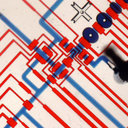Anti-inflammatory sesquiterpenoids from the Traditional Chinese Medicine Salvia plebeia: Regulates pro-inflammatory mediators through inhibition of NF-κB and Erk1/2 signaling pathways in LPS-induced Raw264.7 cells.
Kľúčové slová
Abstrakt
BACKGROUND
Salvia plebeia R. Brown, a traditional Chinese medicinal herb, has been used to treat inflammatory diseases such as cough, hepatitis, and diarrhea for a long history.
OBJECTIVE
The aim of the present study was to isolate and identify potential anti-inflammatory agents from the herb of S. plebeia, which may have contributed to its folk pharmacological use in the treatment of inflammatory diseases.
METHODS
The aerial parts of S. plebeia were extracted with 95% ethanol and separated by silica gel, RP-C18, Sephadex LH-20, and HPLC. The structures of the isolated compounds were elucidated by extensive spectroscopic analysis (MS, NMR, and X-ray). Anti-inflammatory activities of all compounds were evaluated by the model of LPS-induced up-regulated of NO in Raw264.7 macrophages. The expression levels of cytokine (TNF-α) and proteins (iNOS and COX-2) were assessed by ELISA kit and Western blotting analysis, respectively. Furthermore, the influences of salviplenoid A (1) on NF-κB and MAPK signaling pathways were determined by Western blotting analysis and immunofluorescence assay.
RESULTS
Six new (1-6, salviplenoids A-F) and ten known (7-16) sesquiterpenoids were isolated from the herb of S. plebeia. The absolute configurations of compounds 1, 2, and 7 were determined by X-ray diffraction. The new eudesmane-type sesquiterpenoid, salviplenoid A (1), significantly decreased the release of NO and TNF-α and the expression of proteins iNOS and COX-2. In addition, the biochemical mechanistic study indicated that 1 regulated the NF-κB dependent transcriptional activity through inhibiting the nuclear translocation of p50/p65 dimer and decreasing the phosphorylation of IκB and Erk1/2.
CONCLUSIONS
Among all sesquiterpenoids isolated from S. plebeian, the new salviplenoid A (1) exhibited the most potent anti-inflammatory activity in LPS-induced Raw264.7 cells via inhibition of NF-κB and Erk1/2 signaling pathways.




